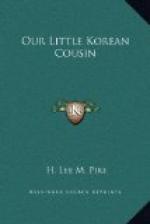It would be impossible to tell in detail about all the strange things Yung Pak saw at this monastery. The chief temple was an enormous structure of stone and tile and carved wood, all decorated in gorgeous combinations of red, green, gold, and white.
Within this temple was one room called the “chamber of imagery.” Inside its darkened walls a single monk chanted his monotonous prayer before an altar. During the chant he also occupied himself by striking a small bell with a deer-horn. Bells played a great part in the worship at Chang-an-sa, and all the prayers were emphasized by the clanging of bells great or small.
Along the shadowy walls of this room could be seen the weapons, as well as the eyes and teeth, the legs and arms, of gods and demons otherwise invisible. These had a ghostly effect on Yung Pak, and made him cling closely to the side of his tutor.
Above the altar before which the priest knelt was an immense carving in imitation of an uprooted tree. Among the roots thus exposed were placed fifty-three idols in all kinds of positions. Beneath the carving were represented three fierce-looking dragons, on whose faces were signs of the most awful torment and suffering.
“About this altar-piece,” said Yung Pak’s guide, “there is a legend you might like to hear.”
“Oh, yes,” was the reply, “tell us the story.”
“Many years ago,” began the guide, “fifty-three Buddhist priests came from India to Korea for the purpose of converting the people to their belief. When they reached this place they were very tired, and sat down by a spring beneath the wide-spreading branches of a tree. They had not been there long when three dragons appeared and attacked the priests. During the contest the dragons called up a great wind which uprooted the tree. In return, each of the priests placed an image of Buddha on a tree-root, turning it into an altar. Thus they were able to overcome the dragons, who were forced into the spring. On top of them great stones were piled, and afterward the monastery of Chang-an-sa was built upon the site of the battle between the priests and the dragons.”
Afterward Yung Pak visited the great kitchens, the dining-rooms, the stables, the private rooms of the monks, and every place which might be of interest to an inquisitive boy of his age.
During the time he remained at Chang-an-sa he made several excursions into the surrounding country, but always returning to the monastery at night.
Meanwhile Ki Pak had transacted the business for which he came to this region, and at the end of ten days was ready to return to Seoul.
Of this journey it is not necessary to tell. No mishap marred the pleasure of the trip, and all returned safe and sound to their home in the capital city of Korea. Yung Pak had enjoyed the journey very, very much, yet he was not sorry once more to be among the familiar scenes and surroundings of home.




